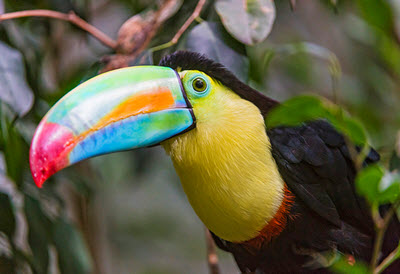The scientific name for the Keel Billed Toucan is Ramphastos sulfurarus. Its popular names include the Rainbow Billed Toucan and the Sulfur Breasted Toucan. Of the large toucan breeds it is the smallest.
Appearance
The Keel billed toucan has black plumage on most of its body but a bright yellow on its chest and cheeks. It has a circle of green around its eyes and bright red feathers under its tail.
It is around 17 to 22 inches tall and weighs around 14 to 18 ounces. Males are usually larger than the females.
Like most toucans, its most notable feature is its brightly colored beak. The beak is green and orange with a tip of red and blue. Though it looks heavy, it consists mainly of a hollow bone frame and keratin (the protein that makes up fingernails). It is four to six inches long or nearly one third of the toucan’s total body length.

They use their beaks to reach for food from nearby branches that would not support their body weight. Their feather like tongue is long and agile and they use it to catch lizards and insects.
It has recently been discovered that their beaks also act as way for the toucan to regulate its body temperature. When blood flows to the beak heat is released, keeping the bird cooler in its tropical surrounding. Since birds can’t sweat this is vital to its survival in high temps.
Like other toucans the Keel billed toucan is zygodactyious. This means it has two toes pointing backwards and two forward. This it allows it to have a strong grip on tree branches as it moves from tree to tree. The toes of the keel billed toucan are blue.
Habitat
The Keel billed toucan lives in tropical and sub-tropical environments, usually in Central or South America.
They make their nest in the hollows of trees and often share this nest with other birds.
The Keel billed toucan lives in the top layer of the forest called the canopy.
Behavior
Because of its broad, heavy wings the Keel toucan, like other toucans, can only fly short distances. It spends most of its time hopping from tree to tree. The keel is most active at dawn and dusk making it crepuscular.
The Keel toucan is a social creature and lives in small flocks of six to twelve birds. They will often use their large beaks to toss food to one another.
They have a loud call that sounds almost like a frog. It can be heard half a mile away. They use their loud call to warn other toucans about potential dangers.
Mating
The Keel Toucans reach sexual maturity at three or four years old. They will lay two to four eggs in a nest in a tree. Both parents protect the eggs until they are hatched and then care for the chicks.
Eggs hatch within eighteen to twenty days. The chicks stay in the nest for eight weeks until they grow feathers and their beak. Young birds stay with their parents for several months until they are able to care for themselves.
It is believed that toucans are monogamous.
Diet
Like other toucans, the Keel toucan eats a diet that consists mostly of fruit. It will, however, also eat insects, tree frogs, eggs and lizards when available.
It tosses its food into the air and then catches it. The keel helps disperse fruit seeds throughout the rain forest thus helping the ecosystem produce new fruit trees.
Though the Keel lives in the upper part of the trees it will occasionally swoop down for low fruit or to search the underbrush for lizards.
Dangers
The Keel toucan is not currently on the endangered species list. However, like all wildlife in the rain forest, it will suffer if its natural habitat continues to be destroyed.
Larger birds, such as hawks, are a danger to toucans as well as wild cats. Rats, monkeys and lizards sometimes attempt to steal and eat the toucan’s eggs from the nest.
There is still some danger from hunters who kill the birds for their meat and to collect their colorful tail feathers or beaks to sell.
Like other toucans, the keel toucan is susceptible to an iron storage disease called hemochromatosis.
Cultural Impact
The Keel Toucan is the national bird of Belize and tourists often visit just to get a glimpse of the beautiful birds.
As Pets
The Keel Toucan is not considered the best pet for a variety of reasons.
These birds have not been domesticated over the years like cats and dogs. They are usually only a generation away from being in the wild and their behavior reflects this. They need a lot of space to move around in and will not do well in a confined area.
They need a lot of attention and cannot be left alone all day while their owner works.
The mess they make can be overwhelming. They throw their food in the air and don’t catch it all. They poop a lot.
Their diet in the wild consists mainly of fresh fruit and this should be continued in captivity. They should not be given citrus fruits. Canned or frozen fruits are not adequate. They also need a supplement of a low-iron protein source.
You must have a large budget to even consider one of these birds for a pet. They cost thousands of dollars to purchase but that is only the beginning. Setting up the large cage, buying toys, providing fresh fruit on a daily basis, getting medical care when needed can be expensive. These costs should be carefully considered in advance.
In captivity they can live over twenty years so they are a long-term commitment.
In Zoos
Because of its interesting appearance the Keel-billed toucan is popular in zoos. It does well if it’s given the proper environment and space. It is an intelligent bird and can be taught tricks with the help of a patient trainer.